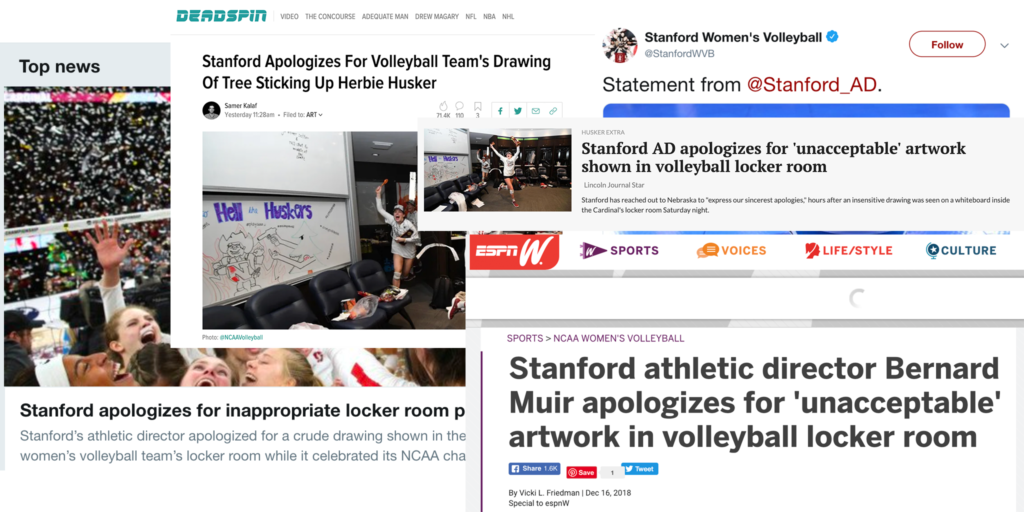Following the 2018 NCAA National Championship match for Women’s Volleyball, we witnessed a great lesson in what not to do when covering your school’s event. Minutes after the game was over, the NCAA tweeted a photo from the official NCAA Volleyball account of a photo of two Stanford volleyball players running into the Stanford locker room holding the trophy. However, in the background of this photo was an image on a whiteboard depicting the Stanford Mascot (a Tree) making a gesture and pointing a gun at the losing team, Nebraska’s mascot.
Congrats on the title, but maybe don’t shoot Herbie in the head with your tree mascot? (Pic: @NCAAVolleyball – deleted) pic.twitter.com/GXEFzDHMlC
— Bill Schammert (@BillSchammert) December 16, 2018
The image was deleted minutes later and replaced with a firestorm of social media activity started from individuals who had taken screenshots and shared online.

As content creators and social media managers, what can we learn from this incident?
You don’t have to be first. In this instance, the person taking the photo was likely the only person with access to take that photo and yes, we want to get the photo out quickly, but a more careful evaluation may have made you think twice.
It’s not just about the subject. When posting anything to social media, you have to consider how it looks from all angles. In this case, the subject of the photo should have been the joy on the faces of the players. Winning a national championship is something to be celebrated, but instead, the whiteboard image overshadowed the main subject.
Mistakes can be harmful to others. In this case, social media management was done by the NCAA and the photo was later deleted by the NCAA Volleyball account. However, the damage had already been done. The mistake forced Stanford’s Athletic Director to apologize for the image. In fact, the following day, the top headline was about Stanford apologizing for their whiteboard, not Stanford winning a national championship.
Digital Citizenship is a form of Sportsmanship. Just as we encourage students to create meaningful content, we should be encouraging student-athletes to consider how images on and offline display sportsmanship. If you want to learn more about this, we encourage you to listen to this podcast episode.
The following are conversations starters for educators when discussing this case study in the classroom:
How could you have shared this image without creating conflict?
Who was responsible for creating the conflict? (The photographer, the social media manager from the NCAA, the whiteboard artist, Stanford players, Coaches?)
How does this image impact Stanford and the players in the photo? Do you think the players in the photo would be proud of this photo?
What kind of legacy does this photo leave behind?
How will you use this case study to create meaningful content?
